Press release from August 26, 2010
Scientists receive 2010 Erwin Schrödinger Prize for developing "arsenic detector"
Berlin. Millions of people, in Southeast Asia in particular, suffer from chronic arsenic poisoning due to drinking water contaminated with the substance. Until recently, complex chemical analyses were required to determine arsenic levels, but now a new biological testing procedure can deliver reliable results inexpensively. The new method was developed by Professor Hauke Harms and Dr Mona C. Wells of the Helmholtz Centre for Environmental Research (UFZ) and Professor Jan-Roelof van der Meer of the University of Lausanne. For their work, the researchers have been awarded the 2010 Erwin Schrödinger Prize, which is endowed with €50,000. The President of the Helmholtz Association, Professor Jürgen Mlynek, will present the prize at the Helmholtz Association’s General Assembly on 16 September 2010.
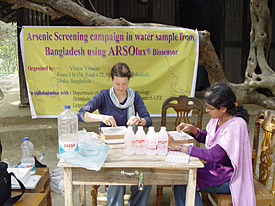
Field measurements in Haziganj / Chandpur Destrict, Bangladesch
Photo: Carola Endes/UFZ
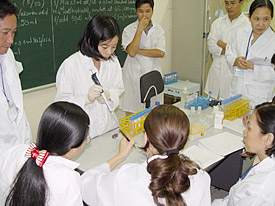
Laboratory measurements and training of staff and students in the CETASD - Centre for Environmental Technology and Sustainable Development in Hanoi, Vietnam
Photo: Prof. Hauke Harms/UFZ
A highly poisonous substance, arsenic finds its way into drinking water in some parts of the world due to geological conditions or mining activity. Over 100 million people are at risk, especially in Southeast Asia, where rapid population growth has made it necessary to tap groundwater from deeper levels in recent years. Chronic arsenic poisoning can severely damage the skin, kidneys and liver, and can even lead to cancer. There are also certain regions in Germany where ore mining has contaminated the groundwater with arsenic. In Southeast Asia, local variations in arsenic levels are so great that ideally every well should be tested - which was virtually impossible up to now because it required complex laboratory tests that had to be carried out by experts.
Teams of scientists led by Professor Hauke Harms, Dr Mona Wells and Professor Jan Roelof van der Meer have come up with a new method that indicates arsenic levels in water reliably within just two hours (incubation period). Patented under the name ARSOlux®, the new test is easy enough for laypeople to use correctly. The basic principle behind the test was developed at the University of Lausanne in Switzerland by Professor van der Meer and his team. Based on microbiological findings, it uses bacteria as so-called "bioreporters". Through genetic engineering, bacteria strains are enhanced with "reporter genes" that cause the cells to glow when exposed to arsenic. The method was systematically refined over the past several years by Professor Harms and his team of researchers in the Department of Environmental Microbiology at the Helmholtz Centre for Environmental Research. The genetically modified bacteria are freeze-dried and stored in test tubes until they are needed. For the actual test, the test tube is filled with water and inserted into a small device that measures how much light is emitted by the bacteria. This luminescence is a measure for the arsenic concentration in the water sample. Using mathematical methods, Dr Mona Wells of the UFZ has managed to improve the reliability and precision of the test to the point that it is actually more accurate than simple chemical analyses.
At only about $1.50 per test, the ARSOlux® method is significantly less expensive than chemical lab tests, and experts say that it also delivers more conclusive results. Unlike a purely chemical analysis, the bioreporter bacteria show to what extent living organisms would absorb certain chemicals, allowing statements to be made in respect to bioavailability and the health risk posed by substances present in water.
Over the past few years, scientists have tested the method in campaigns carried out in Vietnam and Bangladesh, and have shown that the ARSOlux® test also delivers reliable results under reallife conditions. With financial support from the Helmholtz Enterprise Fund (HEF), the scientists have developed the patented method to the point that it is ready to be marketed and plan to found a company that will manufacture and sell the measuring devices and test kits beginning in 2011. The devices could initially be employed in mobile clinics that drive from village to village in Bangladesh.
Other potential customers would be international aid organisations, which could use the test prior to drilling wells to determine if the well would supply safe drinking water.
About the award recipients:
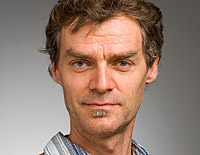
Professor Jan Roelof van der Meer is a microbiologist who studies how bacteria metabolise organic chemicals occurring in the environment, developing genetically modified strains of bacteria that can clearly indicate the presence of certain chemicals. He heads a large distinguished team of researchers at the University of Lausanne.
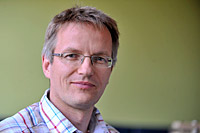
Professor Hauke Harms works in the interdisciplinary field between biology and physical chemistry. In particular he studies the bioavailability of chemicals, that is, how chemicals are absorbed by living organisms. He is head of the Department of Environmental Microbiology at the Helmholtz Centre for Environmental Research.
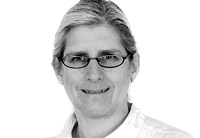
Chemist Dr Mona C. Wells is an expert in the modelling of biological processes and in the recognition of patterns in biological responses to chemical stimuli. She significantly improved the precision and reliability of the new procedure by using statistical methods. A native of the US, Wells has been a visiting scientist at the Department of Environmental Microbiology at the Helmholtz Centre for Environmental Research since 2008.
Contacts for the media:
Thomas Gazlig
Dipl.-Biol./Dipl.-Journ.
Head of Communications and Media Relations, Berlin Office
Anna-Louisa-Karsch-Straße 2
10178 Berlin
Tel/Fax +49 30 206 329-57/60
presse@helmholtz.de
Dr. Antonia Rötger
Press Officer
Tel +49 0 206 329-38
antonia.roetger@helmholtz.de
oder
Helmholtz Centre for Environmental Research (UFZ)
Press Office
Doris Böhme
Tel +49 341 235 1269
presse@ufz.de
At the Helmholtz Centre for Environmental Research (UFZ), scientists research the causes and consequences of far-reaching environmental changes. They study water resources, biological diversity, the consequences of climate change and adaptation possibilities, environmental and biotechnologies, bio energy, the behaviour of chemicals in the environment and their effect on health, as well as modelling and social science issues. Their guiding research principle is supporting the sustainable use of natural resources and helping to secure these basic requirements of life over the long term in the context of global change. The UFZ employs 900 people at its sites in Leipzig, Halle and Magdeburg. It is financed by the German government and by the states of Saxony and Saxony-Anhalt.
The Helmholtz Association contributes to solving major challenges facing society, science and the economy with top scientific achievements in six research fields: Energy, Earth and Environment, Health,
Key Technologies, Structure of Matter, and Aeronautics, Space and Transport. With nearly 30,000 employees in 16 research centres and an annual budget of approximately €3 billion, the Helmholtz
Association is Germany’s largest scientific organisation. Its work follows in the tradition of the great natural scientist Hermann von Helmholtz (1821-1894).
www.helmholtz.de
